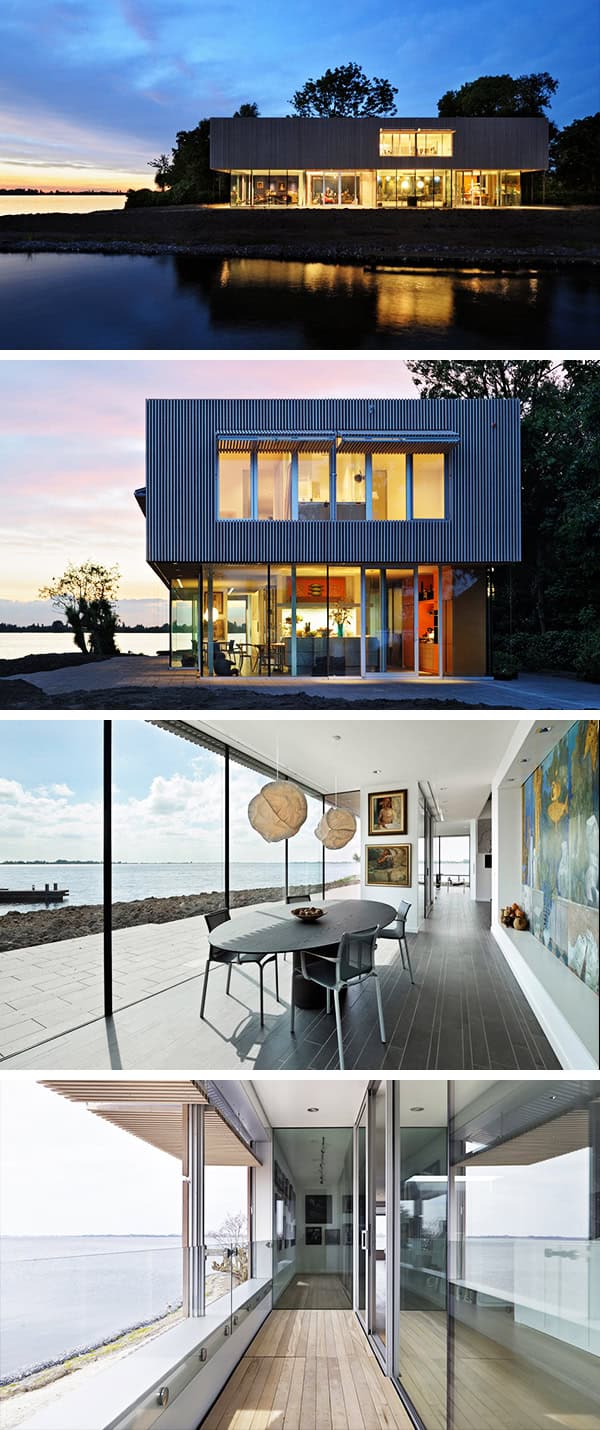Project: Villa Roling
Architects: Paul de Ruiter
Location: Kudelstaart, The Netherlands
Area: 3,659 sq ft
Photographs by: Pieter Kers
Paul de Ruiter is the Dutch architect behind the design of this contemporary lake house in Kudelstaart in The Netherlands. Villa Roling is the luxury home designed for a couple with impeccable tastes in collecting pieces of art.
The ground level of this villa is enclosed in glass that offers some pretty stunning views of the coast of Lake Westeinderplas while the upper floor is surrounded by wood which creates contrast between the two levels.


The clients of villa Röling are passionate art collectors. They love to be surrounded by works of art. Therefore their main wish regarding their new dwelling was that it would do greatest justice to their collection of paintings and sculptures. However, the location of their house, at the edge of the lake Westeinderplas, is so spendid that it was no option to make a closed volume which would have large wall surfaces for hanging on the paintings but would limit the view of the surroundings. The view of the lake and the garden should be maximal. Therefore we decided to design two contrasting volumes, a transparent glass volume overlooking the lake and the garden, and a ´floating´ wooden box on top of it for the works of art.
Incidence of light
The ground floor consists of a series of museumlike ordened spaces, offering varying views of the lake and the surroundings. The overall glass facade folds itself almost invisibly around the spaces and creates a contour which together with the overhanging superstructure alllows for varying incidence of light. At the outside, back from the glass facade, there are cloths which can be pulled up. The cloths not only screen from solar heat, they create a covered and screened off terrace too.
Spatial unity
The wooden box on top has several big openings in it. In the centre of the house there is an empty space with a skylight and all four facades have a large window. At the two ends of the superstructure are the bedrooms with a maximal view of the surrounding nature. Sunblinds, developed by our own, screen from sunlight and solar heat. The sunblinds, made of horizontal slats, move like shutters. Because they consist of two parts with a bend in the middle, the shutters when opened raise like porches above the glass facade. The paintings and sculptures can be exhibited in the centre of the house around the empty space. The empty space unites spatially ground floor and top floor and the skylight allows daylight to enter both floors.
Sustainability
In several ways elements our brought into the design of the villa that lead to very high sustainability. The most important one is hidden in the way the upper volume is placed on top of the other. The overhanging wooden box prevents the sun from warming up the villa by creating shade on the east, west en south side of the villa. Together with the earlier mentioned cloths, the heat of the sun can be kept out. The cloths can be operated apart from each other, which makes it possible to adjust the way the cloths are pulled down to the position of the sun. The sustainability and durability of the upper wooden volume is guaranteed by the way the wooden slats are placed. Because the wind can blow through, the wood can easily dry when it has rained. This way, the wooden volume maintains its original appearance and quality.
Geothermal power
Through the whole of the villa active concrete regulates the temperature in the villa in an innovative and energy-saving manner. Water pipes were set in the concrete floors and these cool the concrete floor in summer and heat it up in winter. This system is connected with a system of geothermal power. Several meters from the villa pits are placed in the ground from which water with a constant temperature can be extracted and pumped into the villa. The water is cool enough in summer and only needs to be heated a few degrees in winter. This way a huge amount of energy can be saved.
This website uses cookies.